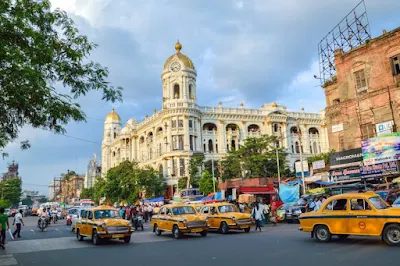Dharmatala
Naming
Dharmatala Street has been renamed after Lenin
as Lenin Sarani but the neighborhood up to Wellington Square continues to be
referred to as Dharmatala. Dharmatala means Holy Street. It is commonly held to
derive its name from a large mosque that stood at the site of Cook and
Company's livery stables. Some discern the name as a reference to dharma, one
of the units of the Buddhist Trinity. There was a Buddhist temple at Janbazar,
nearby. Tipu Sultan Mosque at the corner of Chowringhee Road and Dharmatala was
built in 1842, by Prince Gholam Mohammad, son of Tipu Sultan. Another theory suggests
that the name Dharmatala is because of the preeminence of Dharmathakur in the olden
days. Haris and Doms, who are worshippers of Dharmathakur, predominated the
area even in the memorable past.
 |
| Tipu Sultan Mosque, Dhuramtalah Street, Calcutta, 1832 |
History
In the 18th century, Dharmatala is described
as ‘a well-raised causeway, raised by deepening the ditch on both sides. It
was shaded with trees on both sides.
Just north of Dharmatala a creek formerly ran
from Chandpal Ghat to Beliaghata (or Baliaghata, as it was then known). The creek
passed through what was later Wellington Square (renamed Subodh Chandra Mallick
Square) and Creek Row. The earlier name of Creek Row was Dhinga Bhanga, as a
ship broke there during the cyclone of 1737. The creek was navigable for large
boats. Wellington Square was a tank made on the bed of this creek. Both
Wellington Square and Creek Row were developed by the Lottery Committee.
Calcutta Gazette of 9 August 1821 refers to Wellington Square as ‘the new
square in Dhurrumtollah.’
 |
| Chandpal Ghat |
While the English quarter was then restricted
to around the old fort (present B.B.D.
Bagh), the area south of Dharmatala was a
jungle. The native quarters to the north consisted of a number of straggling
villages.
After their victory in the Battle of Plassey, the
English decided to build a new Fort William, in 1758. For this purpose, the native population
shifted from Gobindapur mostly to Sutanuti. The European inhabitants of Kalikata gradually forsook
the narrow limits of the old palisades and moved to around the Maidan.
The area lying between Dharmatala and
Bowbazar was full of tortuous and narrow lanes, badly drained and reeking with
foul odors, thickly populated and miserably housed. In this area on the
northern side of Dharmatala is a bazaar called Chandni Chowk. It is a
labyrinth of ill-kept passages, lined with shops, in which may be found a
wonderful collection of sundries, from a doornail to a silk dress.
Geography
Dharmatala extends from Chowringhee Road (renamed
Jawaharlal Nehru Road) to Nirmal Chandra Street. It is bounded to the north by Bowbazar, the south by Janbazar, the east by Taltala, and the west by Maidan. The neighborhood
is spread over 2 wards: 46 and 47 of Kolkata
Municipal Corporation.
 |
| Maidan, Kolkata |
Establishment of Dharmatala Market
Dharmatala Market was established in 1794 at the corner of Dharmatala and Chowringhee. Rudyard Kipling in the last chapter of his Kolkata sketches published under the title of “The City of Dreadful Nights” has given a lively description of the market and its frequenters. It was formerly called Shakespeare’s Bazar. |
| Dharmatala Market |
Transport
Then the truly successful horse-drawn public
transport was the tramcar, which was introduced in Dharmatala in March 1882. In
1899, the Calcutta Tramways Company started electrifying the entire system.
Dharmatala has always been a major traffic
hub. Today, Dharmatala is the busiest bus terminus of West Bengal. Kolkata trams route no. 5,
25 and 36 also start their journey from Dharmatala. During rush hours some
200,000 to 300,000 vehicles pass through Dharmatala. In the Dharmatala area,
the noise levels are 75–84 dB.
 |
| Trams of Dharmatala |
According to transport department officials,
over 2,000 long-distance buses operate from the city. Most of the state and
private buses originate from here. The Esplanade Metro Station of Kolkata Metro opened on
October 24 1984 with the opening of the Esplanade Bhawanipur Section of Line 1. 10 years later,
the line was extended Northwards up to Chandni
Chowk. Both these stations in the
Dharmatala Area is among the busiest in the network. Just below the existing
Metro station of Line 1, another station is under construction for Line 2 of Kolkata Metro.
It will be the extension of Line 2 from Salt
Lake Stadium up to Howrah Maidan going
beneath the Ganges, with an interchange with Line 1 at Esplanade.


Wow, perfect ❤
ReplyDeleteThank you.. keep support..
DeletePost a Comment